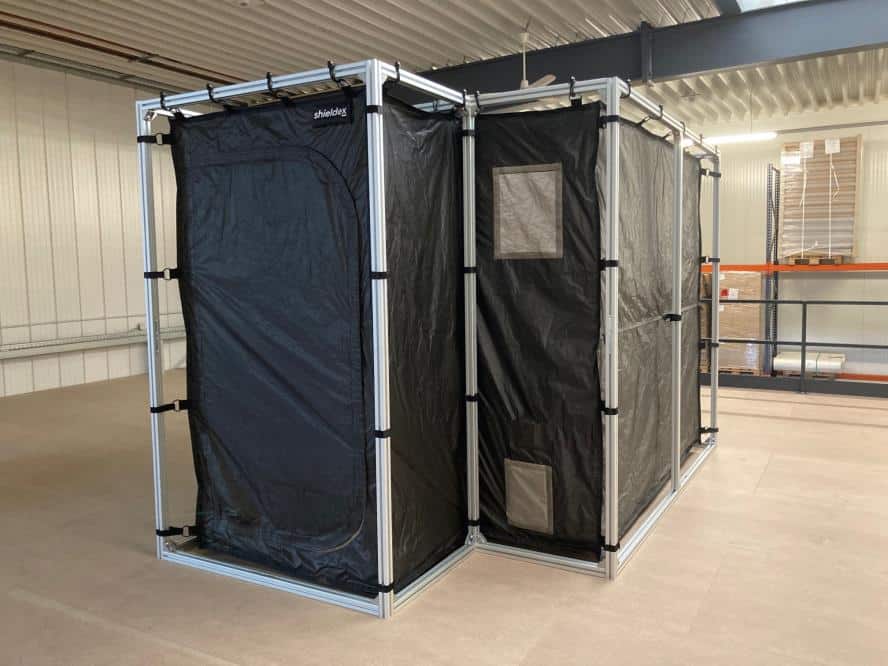Comprehensive Overview to Faraday Cage Rochester: Necessary Electronic Devices Protection
Comprehensive Overview to Faraday Cage Rochester: Necessary Electronic Devices Protection
Blog Article
Exploring the Versatility of Secured Examination Units in Various Digital Checking Circumstances
In the realm of digital testing, the importance of shielded examination units can not be overstated. From electro-magnetic compatibility screening to signal stability assessments and beyond, protected test rooms use a level of precision and control that is essential in today's complex electronic landscape.
Importance of Secured Examination Units
The importance of shielded examination units in electronic testing can not be overstated due to their critical role in ensuring reputable and precise examination outcomes. Secured examination enclosures offer a controlled testing atmosphere by preventing exterior electro-magnetic disturbance from influencing the efficiency of digital devices under examination. This securing is essential for keeping the honesty of the screening procedure, particularly when managing sensitive parts or signals that can be conveniently affected by external elements.

In essence, the importance of shielded examination rooms depends on their capability to create an interference-free and steady testing atmosphere, eventually adding to the accuracy, reliability, and honesty of electronic testing procedures.

Applications in Electromagnetic Compatibility Testing
With the fundamental role of shielded examination enclosures in guaranteeing exact and reliable electronic screening outcomes developed, their application in electromagnetic compatibility screening emerges as a vital element in validating the durability of electronic devices against outside electro-magnetic interference. In electromagnetic compatibility testing, protected examination enclosures play an essential role in developing controlled testing environments that imitate real-world electro-magnetic problems. In general, protected test enclosures are indispensable tools in electro-magnetic compatibility testing, giving a controlled environment for exact analysis and recognition of electronic devices' durability against electro-magnetic interference.
Enhancing Signal Stability Examining
Just how can secured examination units elevate the precision of signal honesty screening in digital tools? Secured examination enclosures play an essential function in improving signal integrity testing by providing a controlled atmosphere that reduces exterior disturbance and sound. These enclosures create a protected area that isolates the device under test from external electro-magnetic areas, guaranteeing that the signals being gauged accurately stand for the gadget's true efficiency.
By decreasing electro-magnetic disturbance, secured examination units assist designers achieve much more reliable and exact measurements of signal integrity specifications such as rise time, jitter, and crosstalk. This precision is necessary for assessing read this article the top quality of high-speed digital signals and making sure that electronic gadgets meet market standards for performance and integrity.
In addition, shielded rooms make it possible for designers to simulate real-world operating problems by creating a regulated electromagnetic environment. This ability is especially beneficial for signal honesty testing in devices that are delicate to outside electromagnetic interference, such as wireless interaction systems and high-speed data networks.
Flexibility in IoT Gadget Testing
Adaptability plays a crucial duty in successfully checking IoT tools for their performance and efficiency across diverse situations. IoT gadgets encompass a wide range of interconnected gadgets, from sensors and actuators to intricate wise systems. Examining the functionality and performance of these devices needs a flexible technique that can adjust to the various communication methods, regularities, and ecological problems that IoT gadgets run in.
Shielded examination units offer the convenience required for screening IoT devices by giving a regulated screening atmosphere that can imitate real-world conditions while ensuring accurate and reliable outcomes. These enclosures can protect against electro-magnetic disturbance, replicate numerous RF environments, and offer a controlled temperature level and moisture setting, permitting for extensive screening of IoT devices in various situations.
Moreover, the convenience of secured test enclosures allows engineers to test IoT tools under different network problems, power degrees, and signal toughness, making certain that the devices can carry out ideally in diverse IoT implementation circumstances. By using secured test units for IoT tool testing, designers can verify the capability, efficiency, and dependability of these gadgets across a large range of real-world conditions, eventually causing the advancement of durable and efficient IoT solutions.
Function in RF and Wireless Screening
Protected test rooms play a critical function in ensuring the precision and integrity of RF and wireless screening for electronic tools (rf test enclosure rochester). These enclosures give an isolated screening environment devoid of exterior disturbance, allowing designers to web measure the real efficiency of RF circuits and wireless interaction systems. By producing a shielded area, these rooms prevent signals from escaping and block external signals from getting in, allowing exact measurements and regular outcomes
In RF screening, secured test enclosures are necessary for reviewing the efficiency of antennas, transmitters, receivers, and various other RF components. The regulated atmosphere within the room helps in identifying the radiation patterns, signal stamina, and regularity response of RF gadgets properly. In wireless screening scenarios, these units replicate real-world problems while ensuring that signals remain had within the test arrangement, without causing interference to a fantastic read outside systems.
Verdict
To conclude, protected examination units play an essential duty in numerous digital screening scenarios such as electromagnetic compatibility testing, signal honesty testing, IoT device testing, and RF and wireless testing. Their flexibility allows for the precise and trustworthy screening of digital gadgets in regulated atmospheres, making sure ideal efficiency and performance. In general, protected examination rooms are necessary devices in the field of electronics testing, providing a secured setting for specific dimensions and analysis.

Report this page